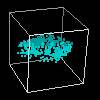
Astronomy and Astrophysics
Glossary
Home
Links
Glossary
Monday
Tuesday
Wednesday
Thursday
Friday
Create Report
- arc second: A unit of angle. One arc second is one sixtieth of one arc minute, and 1/3600 of a degree.
- asteroid: A solar system object. An asteroid is a dense rocky body that orbits the sun, most are founf in an orbit in the Asteroid belt, halfway between Mars and Jupiter.
- astronomical unit (AU): A measure of distance, the astronomical unit is the distance between the Earth and the Sun.
- black hole: A black hole is a region in space where there is so much mass in such a small space that the mass cannot support itself, and collapses to a single point, or singularity. The gravitational pull very close to this point is so strong that not even light can escape if it is within the event horizon of the black hole. Outside of the event horizon, while the black hole would not be directly visible, gravitationally it would be no different than a massive star.
- celestial coordinates: A way of describing the positions of the stars in the sky. The celestial coordinates RA and Dec note position along and off the ecliptic, respectively.
- comet: A solar system object. A comet is a loose compaction of ice and dust which orbits the Sun. Comets are usually found either in the Kuiper belt (around the orbit of Pluto) or the Oort cloud (the outer edges of the solar system, up to 1000 times as far as Pluto from the sun).
- declination: One of the celestial coordinates, declination (or dec) measures the angle above or below the ecliptic at which a a star can be found.
- ecliptic: The ecliptic is the path the Sun makes across the sky. It is to celestial coordinates what the equator is to longitude and latitude on Earth.
- galaxy: A large collection of billions of stars. Our galaxy is the Milky Way, and the Earth is roughly 4/5 of the way out from the center to the edge of the galaxy.
- gravity: All objects feel a force do the mass of other objects, in proportion to the product of their masses, and inversely proportional to the distance between them. This force keeps the Earth in orbit around the Sun, and holds us to the surface of the Earth.
- light year (ly): A unit of distance, a light year is the distance light travels in one year. When we look at an object 100 light years away, the light we are seeing is 100 years old, and we are seeing what the object looked like 100 years ago.
- moon: A planetary satellite. Moons are dense rocky bodies that orbit planets.
- nebula: A cloud of hydrogen gas and carbon and silicate dust in space. Nebulae can be very large, spanning 100s of light years. They tend to be either red, green, or blue, depending on whether we are seeing the hydrogen, oxygen, or scattering off of interstellar dust.
- Newton's Law of gravity: For any two bodies, there exists a force between them which is proportional to their mass and inversely proportional to the distance between them.
- Newton's Laws of motion: laws that describe how the forces that act on an object relate to how that object moves. 1. An object in motion stays in motion unless acted on by an external force. 2. The acceleration of an object is proportional to the force applied to it and inversely proportional to its mass. 3. For every action, there is an equal and opposite reaction.
- parallax: when the observer moves, objects that are closer appear to shift from side to side. This is called parallax, and it can be used to determine the distance to nearby stars.
- parsec: A unit of distance, an object that is one parsec away would have a parallax of one arcsecond. One parsec is roughly three light years.
- planet: A large rocky body formed by the gradual accretion of smaller rocky bodies orbiting around a star.
- right ascension: One of the celestial coordinates, right ascension (or RA) measures distance around the ecliptic.
- star: A round dense ball of hydrogen, in the process of nuclear fusion. Our star is the Sun.
- sun: Our sun is a star, and is by far the largest and most massive object in the solar system. However, it is small to average as stars go. The red giant Betelgeuse is nearly 1000 times larger.
- universe: Everything.